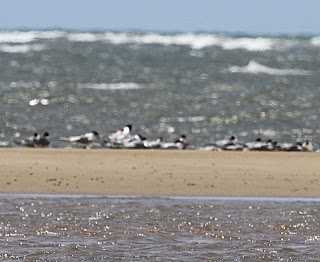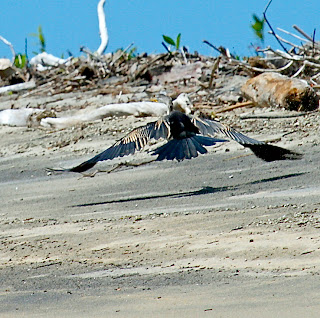New signs have been erected at the end of Coquette Point Road. The signs have been provided as a result of a joint effort from the Cassowary Coast Regional Council, Great Barrier Reef Marine Parks Authority, Birdlife Australia, Wet Tropics management Authority and Wet Tropics of Queensland.
 Three generations of the Epong family belonging to the Mandaburra clan, right to left, Henry, Nellie, James and in the front Michael-John were delighted to inspect the new Coquette Point signs, before going for a walk on the foreshore to see which migratory shore birds had arrived.
Three generations of the Epong family belonging to the Mandaburra clan, right to left, Henry, Nellie, James and in the front Michael-John were delighted to inspect the new Coquette Point signs, before going for a walk on the foreshore to see which migratory shore birds had arrived.The wind was blowing very strongly and a sandstorm occurred as we walked around the low side of the rookery.
In the lee of the dune three pelicans and a darter were sheltering from the wind.
As we approached the darter decided to go fishing
It slowly walked down the beach stretching and lifting its giant wings.



Heading into the wind darter flew towards the South.
On the beach the pelicans stirred.

I am sure I heard the big male pelican tell Chrino to wake up and catch some fish.
Chrino stretched gave a big yawn and they went for a short walk down the beach and sat down again, changing his minds when he saw the sandstorm. Ah well! Why work when you can lie about in the sun on the beach out of the wind.

As we walked around to the ocean front beach several birds with distinct markings landed on the sand in front of us. Ruddy Turnstones are the latest migratory waders to arrive at Coquette Point and they come all the way from Siberia and the high Arctic regions. These amazing birds have been tracked to measure their flight and they have recorded flights of 27,000 km on return trips back to Australia.
Ruddy Turnstones fly at an average speed of 55km per hour and often journey alone or in small groups.
The Bar-tailed Godwit is another migratory wader which flies long distances. This year two Godwits wintered over at Coquette Point but now they have been joined by six other Godwits and no doubt more will arrive as the season gets underway.


 Far out on the most distant sandbar a group of terns were resting between fishing forays. The dark red, large beaks of two Caspian terns could easily be seen with the Crested Terns. As I watched another flock of Crested Terns returned from the sea and settled down on a nearby sandbar.
Far out on the most distant sandbar a group of terns were resting between fishing forays. The dark red, large beaks of two Caspian terns could easily be seen with the Crested Terns. As I watched another flock of Crested Terns returned from the sea and settled down on a nearby sandbar.How wonderful to be surrounded by calling sea-birds with the wind blowing strongly and the waves crashing white on the long sandbar.

It is the shallow sandy estuary of Gladys Inlet that makes Coquette Point an ideal feeding and breeding habitat for foreshore birds.
Looking north toward Flying Fish Point, at low tide the sand flats stretch wide and are dotted with the activity of the many crabs which live beneath the sand.
Looking south to Thompson Point the wind and wave action create rippled patterns in the sand. The Green rainforest hills of the Moresby Range National Park meet the in-shore coral reef. But beware do not dawdel in Gladys Inlet as the tide moves in ever so quickly. The only way out is walking across Crocodile Creek!!!!!!!!
The Osprey chicks did hatch as I first called on the 22 July 2013. However, getting good photos has proven problematic. As soon as mother Osprey spies an intruder she signals to the chicks to stay hidden. I erected a hide but she is smart and knows when I am there.
This photo was taken by neighbours with a camera held to a telescope.
On Friday I managed to get a quick qlimps of a bundle of feathers. While I watched one of the chicks put his tail feathers out of the nest and a stream of fecal matter was ejected. It's a shame humans haven't learnt this lesson.

I watched the female osprey fly to a near-by branch. A few minutes later the male turned up with a fish.

The female Osprey turned to the male and I imagine asked for a piece of the fish.

I think his reply was 'No way girly, catch your own fish.'
She stretched her beautiful wings and returned to the nest.


 Brahminy and Whistling kites have been active over Coquette Point this week, their shrill cries carried on the strong winds lashing the coast all week. Squalls have brought winds of up to 55 knots onto the coast.
Brahminy and Whistling kites have been active over Coquette Point this week, their shrill cries carried on the strong winds lashing the coast all week. Squalls have brought winds of up to 55 knots onto the coast.Long lines of pumice has washed up in some parts of the exposed beach. The pumice has been in the water for a long time as small shellfish adhere to the larger pieces. Some long ago volcanic activity in the Pacific sent it on a sea-voyage to our coastline.
In the estuary the beach is covered in broken shells carried in from the gales hitting the offshore reef, all this week.

Cassowary Jessie and Snout are still courting, however, Snout is very nervous and runs off at the first sight of a human. I think it could be the strong winds or it may be a natural hormonal change as he approaches his incubation tasks. Jessie is her normal calm self and stood tall for this photo.

Cassowary Little Dad is still caring for his chick which is now just over one year old. Thanks to Julie Miller for the photo from her backyard.

Three year old cassowary Don has been walking on the grassed footpath alongside the Coquette Point Road and Julie snapped this shot of him this week.

Stop the squeeze on the environment.
We were mucking about with some old irrigation gear this week and a beautiful Amethystine python emerged. It is timely to remember that many snakes are becoming more active as the weather warms and old cyclone rubbish or piles of building material are good wintering-over habitat for snakes. Before you lift any old stored materials take a good look underneath.
The 2013 election results tonight show a landslide win for the LNP. If you are concerned about the LNP putting the squeeze on the environment then it is up to you to voice concern to your local politician.
Tony Abbot has signalled that he will dismantle the EPBC Act and will allow all development approvals to be made by the States. The Federal Government wants to offload its responsibility for Nationally Threatened Species. It is ironic that today is National Threatened Species Day commemorating on this 7th day of the month 77 years since the last Tasmanian tiger died in the Hobart Zoo.
With the alignment of Venus and Mars tonight proclaimed by astrologers to bring happiness, I think perhaps in Australia's case it will only apply to LNP politicians and their supporters.
If you care for threatened species tell your politicians and ask them to shoulder their responsibilities for animals which know no State Boundaries. It is up to us to make sure that all Australian's threatened species are still around in 2090, 77 years from now.
Until next week,
Yvonne














No comments:
Post a Comment